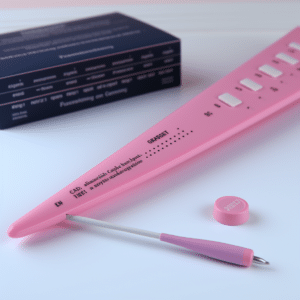Accurate Pregnancy Test Interpretation: Tips and Guidelines
Pregnancy test interpretation, Pregnancy tests are a popular way to find out if you’re pregnant or not. These detect hCG, a hormone made by the placenta when a fertilized egg implants in the uterus. To get accurate results, read and follow the instructions of your test.
Most tests have two result windows. Positive results show both lines; negative results show only control. Take the test after missing your period for better accuracy.
If the results are unclear, it may mean the test was taken too early. False-positives or negatives can happen too, so see a doctor for further tests. Blood tests and ultrasounds will give the most accurate results.
Understanding Pregnancy Tests

Pregnancy test interpretation, Interpreting pregnancy tests can be tricky. Positive results mean the woman is pregnant, and negative results mean otherwise. Yet, false negatives can happen if the test is taken too soon or there is a problem with the test. So, it is imperative to read and understand the instructions each brand provides.
Generally, these tests detect levels of human chorionic gonadotropin (hCG) hormone released after conception. For greater accuracy, the test should be taken a week after a missed period. If one can’t wait that long, some tests claim early detection. But, their accuracy may vary.
Lastly, it’s best to discuss any doubts or concerns with a healthcare professional. They can provide guidance and run additional tests if needed.
Interpreting the Results
Pregnancy test interpretation, Interpreting the results of a pregnancy test is key. Outcomes and their meanings:
| Result | Meaning |
|---|---|
| Positive | You’re pregnant! The test has detected hCG (human chorionic gonadotropin) hormone in your urine. Make an appointment with your healthcare provider for more info. |
| Negative | No hCG hormone detected, suggesting you’re not pregnant. False negatives can happen if the test is taken too early or instructions are not followed. Consider repeating the test or talking to your healthcare provider. |
| Invalid | This could mean an incorrect test or a faulty kit. Repeat the test using a new kit and read all instructions carefully for accurate results. |
Always refer to the instructions provided with your pregnancy test for details on how to interpret results. Follow the guidelines and consider repeating the test if needed.
Factors Affecting Test Results
The accuracy of a pregnancy test can be influenced by various things. Such as the timing, the sensitivity of the kit, and medications or medical conditions that may affect hormone levels. Here’s the breakdown:
- Timing: When taking the test is important. Test too early, before the hCG levels are high enough, may give a false negative result. So it’s best to wait until after your missed period.
- Sensitivity: Different tests have different sensitivities. Some test for lower levels of hCG, while others need higher concentrations. A more sensitive test will give better results sooner.
- Medications and Medical Conditions: Meds like fertility drugs or hormonal therapies, or medical issues like PCOS or tumors, can mess with the results.
To get the best results, follow the instructions for the specific brand of test you’re using. If you think you’re pregnant but get a negative result, see a doctor for further evaluation.
Take action! If you’re unsure about a home pregnancy test, consult with a healthcare provider. Don’t miss out on the chance to get accurate information – your health and well-being are too important!
Tips for Accurate Interpretation

Pregnancy test interpretation, Accurate interpretation is vital for understanding a pregnancy test’s outcome. To guarantee accurate results, consider the following advice:
| Tips for Accurate Interpretation |
|---|
| Pick the right time to test |
| Follow the instructions exactly |
| Get a dependable brand |
| Wait for the prescribed time |
| Read the results in good light |
Moreover, not all tests are equal. Certain brands may provide higher precision rates than others. Thus, it is essential to perform thorough research and select a reliable brand.
It is worth noting that false positives and false negatives can happen with pregnancy tests. False positives can be caused by particular medications or medical conditions, while false negatives may result from testing too early or not following instructions properly.
A study conducted by the American Pregnancy Association discovered that around 5% of women experience false negative results when testing too soon. So, it is important to wait for the recommended time period stated in the instructions before interpreting the results.
To put it shortly, precise interpretation of pregnancy test outcomes calls for careful consideration of various factors such as timing, following instructions precisely, using a reliable brand, and ensuring suitable lighting for reading the results correctly. Doing comprehensive research on different brands and knowing their accuracy rates can also lead to more reliable interpretations.
(Source: American Pregnancy Association)
Conclusion
Interpreting a pregnancy test is key for women. Two lines or a positive symbol mean pregnancy, while one line or a negative symbol means not pregnant. Read the packaging’s instructions carefully to be sure. When to take the test is also important. Too early may result in a false negative. It’s best to wait until period is missed. Follow the test kit’s instructions for accuracy. If a negative result is received but pregnancy is suspected, consult with a healthcare provider. They can do more accurate tests, like blood tests or ultrasounds. Timely and accurate interpretation is important for reproductive journey. Don’t ignore signs. Take charge of reproductive health and interpret results properly. Get peace of mind and reassurance.
Frequently Asked Questions
Q: How does a pregnancy test work?
A: Pregnancy tests detect the presence of a hormone called human chorionic gonadotropin (hCG) in urine or blood. If hCG is present, it indicates pregnancy.
Q: When should I take a pregnancy test?
A: It is advisable to take a pregnancy test after you miss your period or at least one week after having unprotected intercourse for accurate results.
Q: What do the different result lines or symbols on a pregnancy test mean?
A: Generally, a positive result is indicated by two lines, a plus sign, or the words “pregnant.” A negative result is indicated by a single line or the words “not pregnant.” However, it is best to check the instructions specific to your test for accurate interpretation.
Q: What should I do if the result is unclear or invalid?
A: If the test result is uncertain, it is recommended to retake the test in a few days using a new kit. If the result remains unclear, consult a healthcare professional for further evaluation.
Q: Can a pregnancy test give a false result?
A: Pregnancy tests are highly accurate, but certain factors like testing too early, expired tests, or certain medications can lead to false results. It is essential to follow the instructions carefully and retest if there are doubts.
Q: How soon can a pregnancy test detect pregnancy?
A: Some pregnancy tests claim to detect pregnancy as early as six days before the missed period. However, the accuracy increases if you wait until after the missed period to perform the test.






